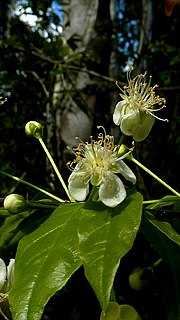
Campomanesia is a genus in the family Myrtaceae described as a genus in 1794. It is native to South America and Trinidad.

Campomanesia aromatica is a species of plant in the family Myrtaceae. The plant is endemic to the Atlantic Forest ecoregion in southeastern Brazil.
Campomanesia espiritosantensis is a species of plant in the family Myrtaceae. The plant is endemic to southeastern Brazil, including in the Atlantic Forest ecoregion.
Campomanesia hirsuta is a species of plant in the family Myrtaceae. The plant is endemic to the Atlantic Forest ecoregion of southeastern Brazil, within Rio de Janeiro state. It is an IUCN Red List Endangered species, threatened by habitat loss.
Campomanesia laurifolia is a species of plant in the myrtle family, Myrtaceae. It is endemic to Atlantic Forest habitats in Rio de Janeiro state of southeastern Brazil. It is a Critically endangered species on the IUCN Red List, and is threatened by habitat loss.
Campomanesia lundiana, also known as the Rio de Janeiro myrtle, was a species of plant in the family Myrtaceae. Before modern extinction, the plant was endemic to Rio de Janeiro state, within the Atlantic Forest ecoregion in southeastern Brazil.
Campomanesia neriiflora is a species of plant in the family Myrtaceae. It is endemic to Brazil. It is threatened by habitat loss.

Campomanesia phaea is a species of plant in the family Myrtaceae. The plant is endemic to the Atlantic Forest ecoregion in southeastern Brazil. It is found in the states of Paraná, Rio de Janeiro, São Paulo.
Campomanesia reitziana is a species of plant in the family Myrtaceae. It is endemic to Brazil. It is threatened by habitat loss.
Campomanesia rufa is a species of plant in the family Myrtaceae. It is endemic to Brazil.
Campomanesia speciosa is a species of plant in the family Myrtaceae. It is endemic to the Amazon basin in eastern Peru and Acre (state) of Brazil. It is threatened by habitat loss.

Campomanesia ilhoensis is a species of plant in the family Myrtaceae.

Helicia is a genus of 110 species of trees and shrubs, constituting part of the plant family Proteaceae. They grow naturally in rainforests throughout tropical South and Southeast Asia, including India, Sri Lanka, Indochina, Peninsular Malaysia to New Guinea and as far south as New South Wales.

Campomanesia lineatifolia is a species of plant in the family Myrtaceae. Common names include guabiraba and perfume guava.
Protea asymmetrica, also known as the Inyanga sugarbush, is a flowering plant, named for its asymmetric flowerheads, of the family Proteaceae and endemic to Zimbabwe and the Nyanga region, where it grows in grasslands, as well as Mount Nyangani.

Campomanesia adamantium, commonly known as gabiroba, guavira, or guabiroba do campo, is a short shrub-like plant that grows no taller than 1.5 meters on average It is natively found in the central part of South America, in Paraguay and Brazil. The plant produces small yellow-green edible fruits

Leucadendron concavum, the Pakhuis conebush , is a flower-bearing shrub that belongs to the genus Leucadendron and forms part of the fynbos. The plant is native to the Western Cape where it occurs at the Pakhuis Pass in the Cederberg.
Leucadendron cryptocephalum, the concealed conebush, is a flower-bearing shrub that belongs to the genus Leucadendron and forms part of the fynbos. The plant is native to the Western Cape and only two populations occur at Potberg and the Groenlandberg. There is little information available about the plant.

Leucadendron flexuosum, the Worcester conebush, is a flower-bearing shrub belonging to the genus Leucadendron and forms part of the fynbos. The plant is native to the Western Cape, where it occurs in the Breede River Valley near Worcester.

Campomanesia guazumifolia is a species of tree in the family Myrtaceae.










